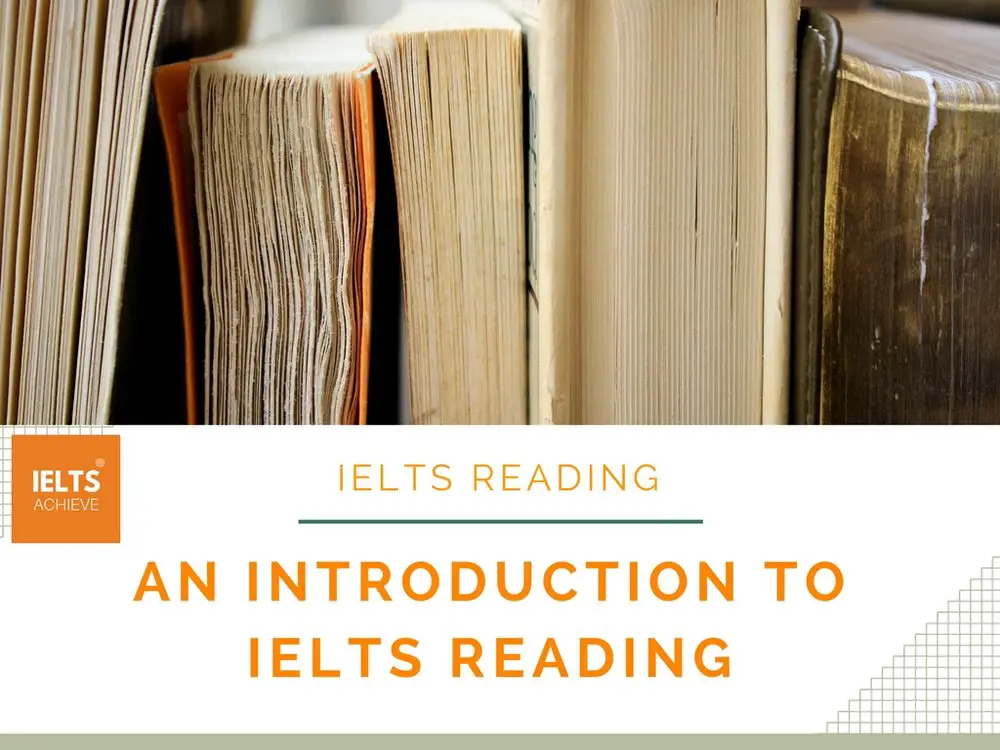Learn How To Complete Each Question In The IELTS Reading Test.
How To Improve Your Reading Skills

Recommended: IELTS Reading Questions and Answers
Reading Band Scores Explained

Learn how to understand the IELTS Reading Band Scores in this post.
Top 5 Reading Tips

Learn How To Speed Read

Skimming And Scanning

Learn how you can improve your skimming and scanning skills for the IELTS Reading Test in this post.
An Introduction to IELTS Reading

Common Question Types in the IELTS Reading Section
You may encounter These common question types in the IELTS Reading section.
Multiple Choice Questions (MCQs):

In Multiple Choice Questions (MCQs), students are presented with a question or statement and provided with multiple answer options to choose from. They need to carefully read the question and analyze the given options to select the one that best matches the information or answer provided in the passage. It requires effective reading comprehension and the ability to evaluate and compare the options to arrive at the correct answer.
Multiple Choice Questions (MCQs) Example
What does the author want to communicate to the reader?
Choose one letter A-D
A. The rising suicide rate of people in New Zealand
B. The appalling data collected of adolescent suicides in New Zealand
C. The growing number of people who have depression and feel isolated
D. A report was commissioned by UNICEF
Identifying Information: True, False, Not Given.

In Identifying Information questions, students are required to locate specific pieces of information within the passage. Carefully read the question and scan the passage to find the relevant details or facts that directly answer the question.
True, False, Not Given Example
Read the text below (from the English History website) and decide if the statements are true, false or not given.
Henry’s first wife, Katharine of Aragon, was the youngest child of the ‘Catholic Kings’ of Spain, Ferdinand and Isabella; she and Henry were married for over twenty years. His second wife, Anne Boleyn, was the daughter of an ambitious knight; she was executed after three years of marriage. His third wife, Jane Seymour, died after less than two years of marriage, having finally produced a son and heir for Henry. His fourth wife, Anne of Cleves, was divorced mere months after the wedding, for Henry found her unattractive and was already courting his fifth wife, Catherine Howard. Catherine was executed after less than two years of marriage and the king settled upon the twice-widowed Katharine Parr as his sixth wife. She outlived the mercurial king.
True – if the statement agrees with the information
False – if the statement contradicts the information
Not Given – if there is no information present
1. Henry’s first wife Katharine of Aragon was the longest relationship he had with any of the wives.
2. Henry Viii favoured his second wife Anne Boleyn above all the others.
Identifying Writer’s Views/claims: Yes, No, Not Given.

In Identifying Writer’s Views/Claims questions, students must determine the author’s opinion or perspective on a particular topic or issue. Carefully analyze the language and tone used in the passage to identify the writer’s viewpoint and select the option that reflects it accurately.
Yes, No, Not Given Example
Look at the opinion piece below from The Guardian – how does the writer share his opinion about the topic?
Answer the following questions (Yes, No, Not Given)
Skim the text and see if the statements below agree with the claims of the writer >>
YES – if the statement agrees with the views or claims
NO – if the statement contradicts the views or claims
NOT GIVEN – it is impossible to say what the writer’s views/claims are
1. The hospital staff were mainly from the UK.
2. The surgical procedure the writer needed was created by a Doctor from the Philippines.
Matching Information

Matching Information questions involve matching pieces of information or ideas from the passage to a given set of options or categories. Match given statements or information with the corresponding section or paragraph in the passage. Read the statements, scan the passage for relevant information, and make the appropriate matches based on keywords or key ideas.
Matching Information Example
Look at the extracts from texts below and match them to the following information >>
- An Effect
- A Date
- A Finding
- An Account
- People worldwide are living longer. Today, for the first time in history, most people can expect to live into their sixties and beyond. By 2050, the world’s population aged 60 years and older is expected to total 2 billion, up from 900 million in 2015.
- According to The World Health Organisation (WHO), a longer life brings with it opportunities, not only for older people and their families but also for societies as a whole. Additional years provide the chance to pursue new activities such as further education, a new career or pursuing a long-neglected passion.
- In fact, in the research paper on ageing by The World Health Organisation (WHO), there is, however, little evidence to suggest that older people today are experiencing their later years in better health than their parents. While rates of severe disability have declined in high-income countries over the past 30 years, there has been no significant change in mild to moderate disability over the same period.
- If people can experience these extra years of life in good health and if they live in a supportive environment, their ability to do the things they value will be little different from that of a younger person. If these added years are dominated by declines in physical and mental capacity, the implications for older people and for society are more negative.
(Information from The World Health Organisation (WHO)
Matching Headings

Matching Headings questions require students to match a set of headings or subheadings with different sections or paragraphs in the passage. Carefully read and comprehend the main idea or theme of each section and match it with the corresponding heading that best represents it. Match headings or titles with the appropriate section or paragraph in the passage. Read the headings, skim the passage to understand each section’s main idea, and choose the heading that best summarizes it.
Matching Headings Example
Read the following headings and then skim read the text, choose the heading that supports the main idea of each paragraph:
What topic do all of the headings have in common? Underline/highlight and keywords.
i. The future of mental health
ii. Violence has a wide scope in urban areas
iii. Support is on offer for youths surviving violent backgrounds
iv. The cause of female and male violence
v. The future of mental health in the school system and beyond
vi. Conflict prevention methods should be used to promote harmony
vii. Knowledge of assaults on women and men
A. Depression is the third leading cause of illness and disability among adolescents, and suicide is the third leading cause of death in older adolescents (15–19 years). Violence, poverty, humiliation and feeling devalued can increase the risk of developing mental health problems.
B. Building life skills in children and adolescents and providing them with psychosocial support in schools and other community settings can help promote good mental health. Programmes to help strengthen the ties between adolescents and their families are also important. If problems arise, they should be detected and managed by competent and caring health workers.
C. Violence is a leading cause of death in older adolescent males. Interpersonal violence represents 43% of all adolescent male deaths in LMICs in the WHO Americas Region. Globally, 1 in 10 girls under the age of 20 years reports experiencing sexual violence.
D. Promoting nurturing relationships between parents and children early in life, providing training in life skills, and reducing access to alcohol and firearms can help to prevent injuries and deaths due to violence. Effective and empathetic care for adolescent survivors of violence and ongoing support can help deal with the physical and psychological consequences.
Matching Features

Matching Features questions involve matching a list of options or characteristics with specific items or examples mentioned in the passage. Carefully read the descriptions or details provided for each option and match them with the appropriate items in the passage based on their features or characteristics. Match given features or attributes with the correct option in the passage. Consider the features and examine the passage for corresponding information or descriptions to make the correct matches.
Matching Features Example
The paragraphs for this practice exercise is from a text called “Giving blood in a time of crisis” from The World Health Organisation (WHO) website.
Read the questions, skim read the following text, and look for the important details:
Prakash Ghimire was just leaving his home in Kathmandu to travel to the airport when the shaking started.
Within a minute, a massive 7.8 magnitude earthquake – the worst to strike the region in more than 80 years – had laid waste to large parts of the city, wreaking destruction that would leave about 9000 people dead and another 22 000 injured.
Half an hour later, Dr Ghimire, a national professional officer at WHO’s country office in Nepal, was at the Health Ministry to join the team assembled at the health emergency operation centre. He was put in charge of coordinating the blood transfusion services, including the availability of blood and blood products in earthquake response operations.
“Immediately after the earthquake, we assembled and started taking stock of what had happened,” he says.
An initial assessment revealed extensive damage to the nation’s blood supply infrastructure. Out of about 100 blood transfusion centres, 9 were completely destroyed and 21 were partially damaged. The Central Blood Transfusion Service building in Kathmandu had large cracks in its walls and was deemed structurally unsound.
There were also deaths and injuries at two of the sites carrying out blood collection activities that day. One Nepal Red Cross staff member, one volunteer and seven donors had died, and others remained trapped in a collapsed donation centre, awaiting rescue.
But Nepal had long feared a devastating earthquake and had made some preparations. The country’s first solar-powered emergency blood transfusion service centre had been inaugurated just five days before the earthquake struck. The designers had predicted that power would be a significant problem after a natural disaster; the rooftop solar panels meant that this was not an issue.
Match the features >>
- Prakash Ghimire
- Dr Ghimire
- Nepal
A. A nurse
B. Place of the earthquake
C. a doctor
D. a blood donor
E. Earthquake victim
Matching Sentence Endings

Matching Sentence Endings questions require students to match sentence endings or conclusions with the corresponding beginnings or introductions provided in the passage. Carefully read and understand the structure, context, and logical flow of the sentences to make accurate matches. Match sentence beginnings with a suitable ending from the passage. Read the sentence beginnings, find sentences or phrases in the passage that complete them, and select the appropriate ending.
Matching Sentence Endings Questions
How can overweight and obesity be reduced?
Overweight and obesity, as well as their related noncommunicable diseases, are largely preventable. Supportive environments and communities are fundamental in shaping people’s choices, by making the choice of healthier foods and regular physical activity the easiest choice (the choice that is the most accessible, available and affordable), and therefore preventing overweight and obesity.
At the individual level, people can:
- limit energy intake from total fats and sugars;
- increase consumption of fruit and vegetables, as well as legumes, whole grains and nuts; and
- engage in a regular physical activity (60 minutes a day for children and 150 minutes spread through the week for adults).
Individual responsibility can only have its full effect where people have access to a healthy lifestyle. Therefore, at the societal level, it is important to support individuals in following the recommendations above, through sustained implementation of evidence-based and population-based policies that make regular physical activity and healthier dietary choices available, affordable and easily accessible to everyone, particularly to the poorest individuals. An example of such a policy is a tax on sugar-sweetened beverages.
Match the sentence endings >>
- Being overweight
- People can
- Society must
A. offer help to those who are overweight, making sure that healthy diet options and regular activities are easily accessible
B. can be stopped, by making changes and receiving help from the community
C. is caused by being irresponsible
D. watch what they eat
E. be careful with their daily eating habits, making sure they consume a healthy amount of fruits and vegetables
F. promote a sugar tax on all unhealthy foods
Sentence Completion:
In Sentence Completion questions, students need to complete a sentence or statement using information or ideas from the passage. Carefully read the given sentence fragment and consider the context and information provided in the passage to choose the correct completion that fits logically and grammatically. Complete the sentence or fill in the missing information in the passage. Read the surrounding context, understand the sentence’s meaning, and provide a suitable completion based on the passage.
Summary, Notes, Table, Flowchart Completion

These types of questions involve completing a summary, notes, table, or flowchart based on the information presented in the passage. Carefully read and understand the passage to extract the key details and organize them in the correct order or format to complete the given summary, notes, table, or flowchart accurately. Complete a summary, notes, table, or flowchart using information from the passage. Read the incomplete task carefully, locate the relevant information in the passage, and use it to complete the given task accurately.
Summary, Notes, Table, Flowchart Completion Questions
Read through the questions and skim read the text, can you answer the questions?
Dementia is a syndrome – usually of a chronic or progressive nature – in which there is deterioration in cognitive function (i.e. the ability to process thought) beyond what might be expected from normal ageing. It affects memory, thinking, orientation, comprehension, calculation, learning capacity, language, and judgement. Consciousness is not affected. The impairment in cognitive function is commonly accompanied, and occasionally preceded, by deterioration in emotional control, social behaviour, or motivation.
- Dementia is a ……………….. which is usually continuous and gradual.
- It can affect many cognitive functions, including ………………………………, …………………., or ………………….
- According to the notes, dementia sufferers …………………… is not damaged.
- Dementia can affect the ability to remember, awareness, direction and ………………
Diagram Label Completion:
Diagram Label Completion questions require students to label or complete a diagram based on the information provided in the passage. Carefully analyze the passage and understand the relationships or components described to correctly label or complete the diagram. Identify and label the parts of a diagram using information from the passage. Examine the diagram and the passage for descriptions or explanations that match the different parts, and label them accordingly.
Short Answer Questions:

Short Answer Questions require students to provide brief, concise answers to specific questions based on the information presented in the passage. Carefully read the question and identify the relevant information or details in the passage to construct a clear and accurate response. Provide concise answers to questions based on the passage. Read the question carefully, locate the specific information in the passage, and provide a brief and accurate response.
Short Answer Questions
Read the following passage and answer the questions with no more than one word.
Leishmaniasis is caused by a protozoa parasite from over 20 Leishmania species and is transmitted to humans by the bite of infected female phlebotomine sandflies. Over 90 sandfly species are known to transmit Leishmania parasites. There are 3 main forms of the disease:
Visceral leishmaniasis (VL), also known as kala-azar is fatal if left untreated in over 95% of cases. It is characterised by irregular bouts of fever, weight loss, enlargement of the spleen and liver, and anaemia. It is highly endemic in the Indian subcontinent and in East Africa. An estimated 50 000 to 90 000 new cases of VL occur worldwide each year. In 2015, more than 90% of new cases reported to WHO occurred in 7 countries: Brazil, Ethiopia, India, Kenya, Somalia, South Sudan and Sudan. The kala-azar elimination programmes in South-East Asia are making sustained progress towards elimination, and cases are declining in the three major endemic countries: Bangladesh, India and Nepal.
Cutaneous leishmaniasis (CL) is the most common form of leishmaniasis and causes skin lesions, mainly ulcers, on exposed parts of the body, leaving life-long scars and serious disability. About 95% of CL cases occur in the Americas, the Mediterranean basin, the Middle East and Central Asia. Over two-thirds of new CL cases occur in 6 countries: Afghanistan, Algeria, Brazil, Colombia, Iran (The Islamic Republic of) and the Syrian Arab Republic. An estimated 0.6 million to 1 million new cases occur worldwide annually.
Mucocutaneous leishmaniasis leads to the partial or total destruction of mucous membranes of the nose, mouth and throat. Over 90% of mucocutaneous leishmaniasis cases occur in Bolivia (the Plurinational State of), Brazil, Ethiopia and Peru.
Questions >>
- The disease is passed on to people from the poison carried by the ………………. Sandflies.
- One strain of the disease can cause death if it is ………………………
- Another strain of the disease can cause skin problems and ulcers, leaving people with marks and sometimes even a severe…………….
- One of the deadliest strains of this disease attacks the …………………. membranes located in the upper part of the body.
Unlock your full potential in the IELTS Reading section – Visit our IELTS Reading Practice Question Answer page now!
Recommended Questions:
